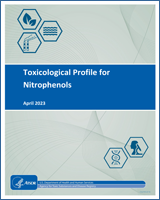NCBI Bookshelf. A service of the National Library of Medicine, National Institutes of Health.
Toxicological Profile for Nitrophenols. Atlanta (GA): Agency for Toxic Substances and Disease Registry (US); 2023 Apr.

Toxicological Profile for Nitrophenols.
Show details4.1. CHEMICAL IDENTITY
Nitrophenols (also referred to as mononitrophenols) exist in three isomeric forms: 2-nitrophenol (or ortho- or o-), 3-nitrophenol (or meta- or m-), and 4-nitrophenol (or para- or p-). All three of these nitrophenols are manmade. Table 4-1 lists common synonyms, trade names, and other pertinent identification information for 2-nitrophenol, Table 4-2 lists this information for 3-nitrophenol, and Table 4-3 lists this information for 4-nitrophenol.
Table 4-1
Chemical Identity of 2-Nitrophenol.
Table 4-2
Chemical Identity of 3-Nitrophenol.
Table 4-3
Chemical Identity of 4-Nitrophenol.
4.2. PHYSICAL AND CHEMICAL PROPERTIES
2-Nitrophenol is a light yellow, aromatic solid; 3- and 4-nitrophenol are colorless to pale yellow solids. The nitrophenols are expected to be highly soluble in water. They also have low vapor pressures, and therefore, low potential for long range atmospheric transport (Harrison et al. 2005). Tables 4-4, 4-5, and 4-6. List important physical and chemical properties of 2-, 3-, and 4-nitrophenol, respectively.
Table 4-4
Physical and Chemical Properties of 2-Nitrophenol.
Table 4-5
Physical and Chemical Properties of 3-Nitrophenol.
Table 4-6
Physical and Chemical Properties of 4-Nitrophenol.
- CHEMICAL AND PHYSICAL INFORMATION - Toxicological Profile for NitrophenolsCHEMICAL AND PHYSICAL INFORMATION - Toxicological Profile for Nitrophenols
- Care, Use, and Welfare of Marmosets as Animal Models for Gene Editing-Based Biom...Care, Use, and Welfare of Marmosets as Animal Models for Gene Editing-Based Biomedical Research
Your browsing activity is empty.
Activity recording is turned off.
See more...